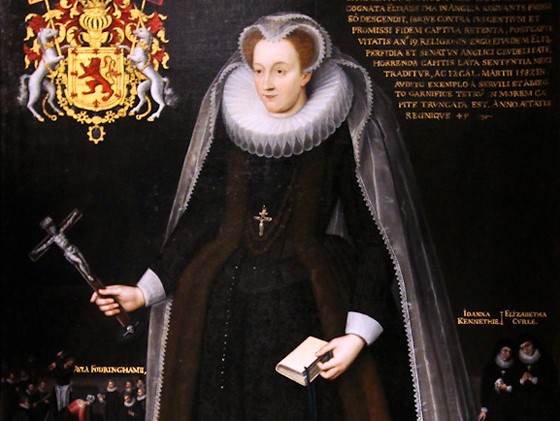William Cecil: Life Story
Elizabeth I’s Chief Councillor
Chapter 11 : Religious Dissent
Following the Act of Uniformity in 1559, Elizabeth was content that religious reform had gone far enough, but not everyone, including probably Cecil, agreed. On the one hand there were the radical Protestants, who became known as Puritans because of their objections to wearing the vestments laid down by the Act, and who strove throughout Elizabeth’s reign to take reform further.
It can be inferred that Cecil was a supporter of a more radical settlement than Elizabeth eventually allowed. He favoured clerical marriage, which she did not; he pointedly refused to support Archbishop Parker’s attempts to enforce conformity in the wearing of vestments, and he also supported the later Archbishop, Edmund Grindal in the dispute over ‘prophesyings’ with Elizabeth that ended in Grindal being relieved of his duties. But for Cecil, the enemies were the Catholics.
In 1558 Catholics were far and away the most populous group in the country, but, like most people in most times, the majority were not interested in religious martyrdom, and whatever their private thoughts, and sometimes practices, they attended church. Over the course of Elizabeth’s reign, as new generations were brought up under the Act, the bulk of the population became Anglicans – essentially Protestant in doctrine, but dressed in the pared down Catholic clothes of ceremony.
A hard core of Catholics remained, and, as time went on, became more troublesome as religion and politics began to mix. In 1568, when Mary, Queen of Scots was deposed and fled to England, the Catholic party wished her to be openly recognised as Elizabeth’s successor, and some even believed that she should already be Queen. For Cecil, this was an intolerable situation – he genuinely believed that the succession of Mary would lead to the re-imposition of Catholicism, and he feared that Elizabeth would be assassinated in order to bring the day forward.
Cecil heartily concurred with the advice of his close colleague, Sir Francis Walsingham that ‘it is better to fear too much, than too little’. He saw plots everywhere, and his whole energies were directed to circumventing them, by fair means, and sometimes by foul.
Cecil’s obsession with Catholic rebels at home, and his desire to support Protest rebels abroad had contributed to deteriorating relationships with Spain. The impounding, on Cecil’s advice, of three Spanish ships carrying gold to the Low Countries for their armies that had taken refuge in Plymouth Sound caused a serious rupture in diplomatic relationships. Many of Elizabeth’s other Councillors, who were becoming restive under Cecil’s dominance, felt he was provoking Spain too far.
A plan was hatched for Mary, Queen of Scots to marry Thomas Howard, 4 th Duke of Norfolk, and a Protestant. Norfolk and Cecil were on bad terms. The proposal was supported not only by Norfolk’s brother-in-law, the Earl of Westmorland, but also by the Protestant Earls of Leicester and Pembroke, and the Catholic Earl of Arundel. The Catholic Earl of Northumberland was not convinced of the merits of the plan, as he did not want Mary to marry a Protestant.
Elizabeth rejected the idea out of hand, and rebuked those Councillors who were criticising Cecil’s handling of foreign policy. But negotiations continued in secret. In July, on a day when Cecil was absent from the Privy Council, the majority agreed that if Mary married a Protestant, she could be freed. Still no-one dared to tell the Queen, until, on 6 th September 1569, Leicester confessed all.
Norfolk withdrew from court, then, when he refused to answer Elizabeth’s summons to Windsor, it was assumed that he had gone to his East Anglian estates to raise and army. In fact, he hadn’t, and on 1 st October wrote to Westmorland to desist from insurrection, whilst he returned to London to throw himself on Elizabeth’s mercy.
The northern Earls, Northumberland and Westmorland, decided to act anyway, although their activities were disorganised and somewhat half-hearted. Cecil’s worst fears were recognised when they raised an army and marched to Durham Cathedral, where a full Roman Catholic Mass was offered. But, as with the Pilgrimage of Grace, thirty years earlier, the south was controlled by the Government, and there was little support for the rising beyond the northern counties. By November, Cecil was reporting that:
‘Our northern rebellion is fallen flat to the ground and scattered away.’
Cecil emerged from the affair stronger than ever, and his anti-Catholic stance seemed vindicated. Unpleasant rumours that he and Bacon were conspiring to have Norfolk (imprisoned in the Tower) murdered were brushed off.
In 1570, the stakes were raised when the Pope finally excommunicated Elizabeth. In his Bull, Regnans in Excelsis, he not only pronounced the Queen a heretic, but also absolved all of her subjects of any oaths of allegiance they might have sworn to her. Even more provocative, the Bull stated that any who obeyed the Queen would be cursed. The words ‘I told you so,’ must have been trembling on Cecil’s lips when Elizabeth heard that this was the result of her toleration of private Catholic practices, and her reluctance to deal too harshly with the Queen of Scots.
The Bull backfired spectacularly. The majority of law-abiding Catholic subjects had absolutely no intention of defying the Queen, or attempting to overthrow her. Even Philip of Spain thought the Bull was the wrong approach. For Cecil, it was grist to his mill. Parliament was called and new laws introduced to not only make it high treason for anyone to ‘reconcile’ to Rome, but also, it became treason to have any ‘ vain and superstitious thing s’ such as crosses, relics, Agnus Dei etc, that had been blessed by the Pope or a priest.
The Commons removed the exemption from the Act of Uniformity, allowing gentlemen with private chapels to attend service there, rather than in the Parish Church, according to the authorised rite. They also tried to impose a requirement to take Communion, which would immediately identify every Catholic who refused. This latter clause was hotly debated. It was one thing to impose attendance, it was quite another to force someone to receive Communion.
The Lords (where Cecil was now seated as Lord Burghley) were not unanimous.At least four of them (Lords Vaux and Windsor and the Earls of Worcester and Southampton) voted against it. The Queen then vetoed the bill. She still would not force consciences (at least, not those of noblemen), provided outward conformity was observed. The cost of failure to attend Church however, was increased, from 1s to £20, enough to ruin most families if they persisted in recusancy.
During the late 1570s, a new Catholic threat became apparent as the English seminary, established in Rome by the Englishman William Allen, and later taken over by the Jesuits, began to send priests into England on a mission both to reinvigorate the recusants, and convert people to the Roman Catholic faith. Within the movement there were many who wanted to concentrate only on religion, and not to embroil themselves in politics. In support of this the Bull, Regnans in Excelsis was modified by Pope Gregory XIII who permitted English Catholics to obey the Queen in civil matters.
One of the most famous of these missionaries was Edmund Campion, who entered England in 1580, and was captured in 1581, tortured, condemned for treason, and hanged, drawn and quartered. There was much unease at the idea of persecution for religion. In 1583, Cecil wrote a tract, the Execution of Justice, defending the deaths of Campion and others and the allegations of torture. In it, he wrote that the torture of Campion had not, contrary to rumour, been so great that he could not walk. He also added that the rack had been managed:
‘ever by those that attended upon the Examinations charged to use it (the rack) in as charitable Maner as such thing might be.’
None of the men questioned had been asked about their religion, only about political matters, and whether, if the Pope commanded them to rebel, they would do so.
As for Alexander Bryant, from whom food and water had been withheld until he was obliged to lick the stones of his prison, well, it was his own fault. In an effort to gain a sample of his handwriting, he had been told to write something, anything, and had refused. He was then told he could have food and water if he would write his request down. His refusal to request food could hardly make the authorities guilty of starving him.
In Cecil’s eyes, the hounding of Catholic priests was completely justified – they sought to overthrow the Protestant state, and kill the Queen. It was apparent that Spain was planning invasion, and the Queen of Scots was still attracting plots. Every weapon had to be used to protect England.
He wrote further advice to the Queen on how to manage Catholics who were suspected of supporting invasion. They should not, he advised, be asked to swear an oath that they would fight against any Popish invasion plans. To ask that would be to render them ‘desperate’, and his view was that desperate men would do desperate deeds. Besides the only way to get rid of desperate men is to kill them, and
‘there are so many it would be as hard and difficult as it would be impious and ungodly’.
Instead, the suspects should be asked to swear that anyone who refused to fight invasion plans ought to be condemned as a traitor. He believed that most would take the oath, as they were not being asked to comment on what they would do in the circumstances. Refusal to take it would immediately show the person as a traitor, but would not be a religious question.
In 1586, yet another plot against the Queen was discovered. It is certainly possible that the Babington Plot was a sting, manufactured by Cecil and Walsingham, but the Queen of Scots fell into the trap. Cecil was determined that this would be her end, and, when she was condemned in a trial at Fotheringhay Castle, over which Cecil presided, he pleaded with Elizabeth to sign the death warrant.
Elizabeth hesitated for weeks, but eventually signed it. Immediately the signed document was given to the Privy Council, which, before the Queen could change her mind, was sent to Fotheringhay and carried out. When she discovered what had happened, the Queen’s rage, real or feigned, knew no bounds. She banished Cecil from court and refused to see him for months.
Still the Catholics refused to go away, and for the remainder of Elizabeth’s reign the spectre of a Catholic invasion, supported by internal traitors remained. Nevertheless, after the defeat of the Armada in 1588, it became obvious that there was no widespread support for foreign invasion or a forcible return to Rome. Although the penalties for recusancy were ruinous, and the government continued to vigorously seek out priests, dragging them from their priest holes, and fining and imprisoning those who harboured them, the level of fear somewhat subsided.











